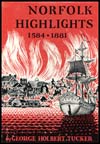Chapter 59
African-Americans in Norfolk
Although it has not always been acknowledged, African-Americans have played an important role in the development of Norfolk since its establishment.
The strength and endurance of African-American men provided the main source of manpower to load and unload the vessels that brought prosperity to the area, while other members of the race faithfully served the private families and public and religious establishments of the growing town, borough, and city as clergymen, teachers, cooks, butlers, waiters, housemaids, nurses, washerwomen, and coachmen.
Black men also distinguished themselves in time of war. For instance, James Thomas served with distinction as a boatswain during the Revolutionary War in the Virginia Navy and was described as a "fellow of daring and, though a man of color, was respected by all the officers who served with him."
Norfolk also had the distinction of having the most publicized school for black children prior to the Civil War. It was established by Mrs. Margaret Douglass, a white woman from South Carolina, who opened classes in Norfolk in 1853 for free black children. Arrested on the charge that slaves were among her pupils, Mrs. Douglass denied her guilt, but was found guilty and sentenced to one month in the Norfolk City Jail, an episode that received national publicity in a book published in 1854.
Norfolk's first free public schools for blacks were opened in 1863 in schools formerly used by white children by order of the Federal occupation forces. In 1865, the Norfolk schools were returned to the use of white children, and black children in the city were without schools until 1867, when the American Missionary Society opened several black schools in the city. This arrangement continued until 1871, when the City Council established a free black school in each of the four city wards and combined all of the schools, white and black, under one superintendent.
Higher education for African-Ameicans came to Norfolk in 1883, when the Norfolk Mission College, which continued until 1916, was established by the General Assembly of the Presbyterian Church.
Norfolk's first African-American newspaper was published by Joseph T. Wilson, a runaway Norfolk slave, who returned from South America to the United States to enlist in the Union Army at the outbreak of the Civil War. Wilson became the editor of the True Southerner in Norfolk in 1866, which he continued to publish until a white Norfolk mob smashed his presses, after which he continued his newspaper career in Petersburg.
In the realm of religion, Norfolk's black Baptists have the oldest history. Norfolk's first Baptist congregation, organized in 1800, was interracial and worshipped in the then abandoned Norfolk Borough Church, now St. Paul's Episcopal Church. In 1815, the white members withdrew and founded Cumberland Street Baptist Church, the mother church of all white Baptist congregations in Norolk. African-American members, served by a white minister, the Reverend James Mitchell, an Englishman, continued as an independent congregation and became the progenitor of First Baptist Church, Bute Street, and Bank Street Church of today.
Grace Episcopal Church, originally called The Church of the Holy Innocents, was founded in 1883 by Negros who had been communicants of Old Christ Church. Norfolk's black Catholics also worshipped with white Catholics until 1889, when St. Joseph's Parish was established for them. Since 1861, they have worshipped in Old St. Mary's Catholic Church.
Norfolk's oldest black Methodist church, St. John African Methodist Episcopal Church, was an outgrowth of a mission for slaves established by Cumberland Street Methodist Church in 1840. The present congregation still occupies the site on Bute Street for its original church in 1848.
The United Order of Tents, J.R.G. and J.U., one of the most important black women's lodges in the country, was also founded in Norfolk by two slave women, Annetta M. Lane of Norfolk and Harriet R. Taylor of Hampton, with the aid of two abolitionists, Joshua R. Giddings and Joliffe Union, whose initials are incorporated into the lodge title. Set up originally as an underground railway for slaves, the lodge threw off its secrecy after the Civil War and was officially organized in Norfolk in 1867.
Chapter
60
Norfolk and the Revolutionary Centennial
Norfolk Highlights 1584 - 1881

See the "Table of Contents" for links to every chapter in Norfolk Highlights 1584 - 1881 by George Holbert Tucker.
